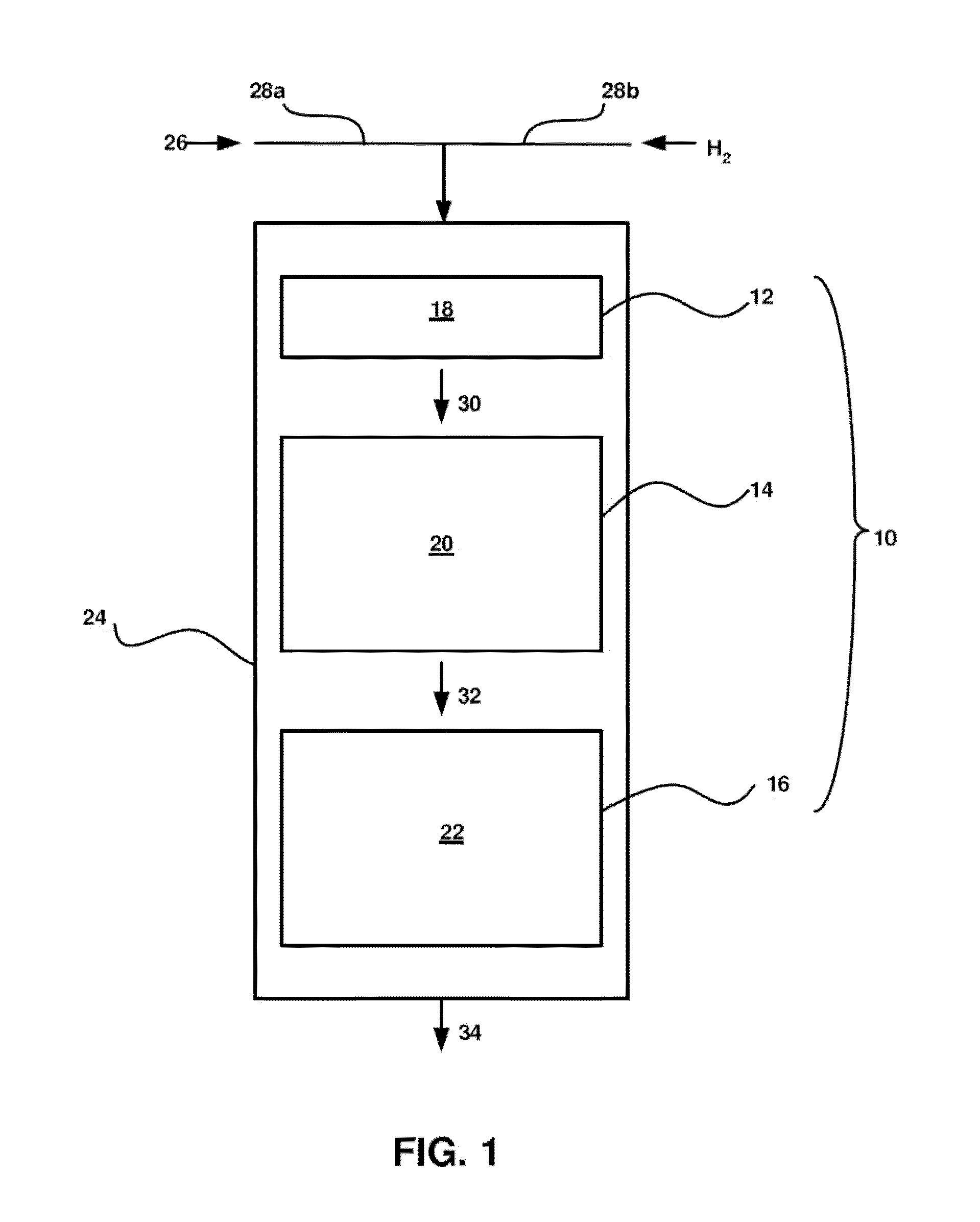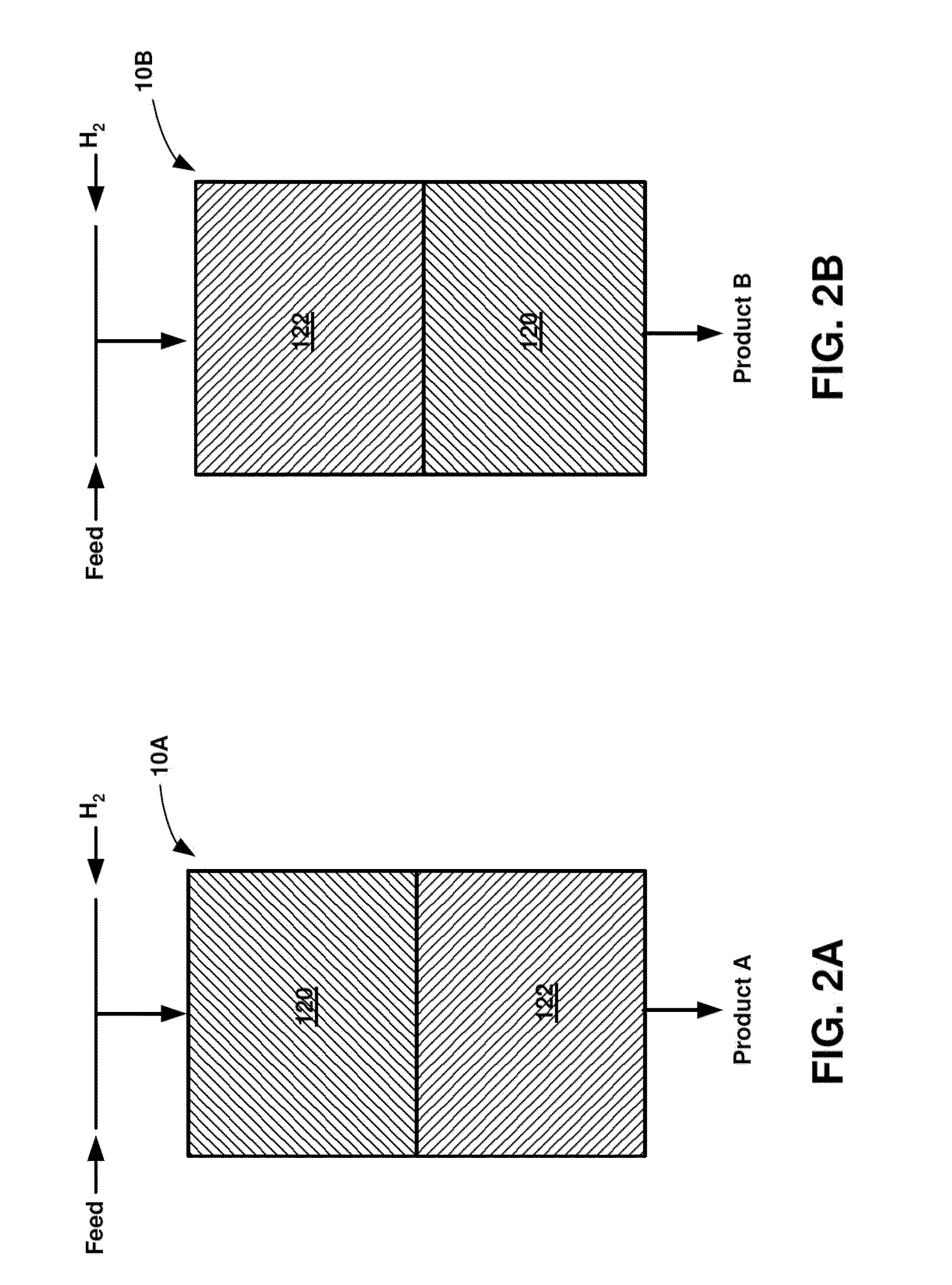Catalytic processes and systems for base oil production from light feedstock
a technology of catalytic processes and feedstocks, applied in the field of catalytic processes and systems for dewaxing hydrocarbon feedstocks, can solve the problems of insufficient current crude oil supplies to meet present demand for such lubricants, and the need to upgrade crude oil fractions otherwise unsuitable for lubricant manufacture, so as to reduce the pour point and cloud point of the base oil product, and the viscosity index is high
- Summary
- Abstract
- Description
- Claims
- Application Information
AI Technical Summary
Benefits of technology
Problems solved by technology
Method used
Image
Examples
example 1
[0088]Hydroisomerization catalyst A was prepared as follows. Zeolite SSZ-32 was composited with alumina to provide a mixture containing 45 wt. % zeolite, and the mixture was extruded, dried, and calcined. A metal-modified catalyst was then prepared by impregnating the dried and calcined extrudate with a solution containing both platinum and magnesium. The co-impregnated catalyst was then dried and calcined to provide an overall platinum loading of 0.325 wt. % and a magnesium loading of 2.5 wt. %.
[0089]Hydroisomerization catalyst B was prepared as follows. Zeolite SSZ-32 was composited with alumina to provide a mixture containing 65 wt. % zeolite, and the mixture was extruded, dried, and calcined. The dried and calcined extrudate was impregnated with a solution containing platinum, and the Pt impregnated catalyst was then dried and calcined. The overall platinum loading was 0.325 wt. %.
[0090]Hydrofinishing catalyst C was prepared by impregnating silica-alumina (SIRAL®-40, Sasol) with...
example 2
Dewaxing Light Feed using Layered Catalyst System A / B
[0095]The light hydrocarbon feed as described in Example A was dewaxed using a layered catalyst system comprising 4 cc of catalyst A (crushed 24 / 40 mesh) disposed over 4 cc of catalyst B (crushed 24 / 40 mesh), such that catalyst B was downstream from catalyst A (see, e.g., FIG. 2A). The dewaxing conditions were as described in Example A, except the gas / oil ratio was 3000 scf / bbl, and the dewaxing temperature was adjusted to 625° F. to achieve the target pour point. The effluent from the layered catalyst system was hydrofinished as described in Example A to provide a base oil product at a yield of 88.9% (wt. % 600° F.) with a pour point of −14° C. and a VI of 108 (Table 2).
example 3
Dewaxing Light Feed using Catalyst System A / B with a Temperature Differential
[0097]The light hydrocarbon feed as described in Example A was dewaxed as described in Example 2, except a 40° F. temperature difference was maintained between catalyst A (595° F.) and catalyst B (635° F.). The yield of base oil product was 89% (wt. % 600° F.) with a pour point of −12° C. and a VI of 108 (Table 2). The superior results, as expressed by yield and VI, obtained using the layered catalyst system configuration of Example 2 were once again evident during dewaxing in the presence of a temperature differential within the catalyst system.
[0098]
TABLE 2Base oil product yields and characteristicsDewaxPour PointExampleCatalyst(s)Yield1(° C.)VIAB86−12107BA88.5−13108CB / A87.3−131062A / B88.9−14108D2B / A87−1410732A / B89−121081Yield is expressed as wt. % (of the feed) that boils at 600° F. or higher2Dewaxing with a 40° F. temperature difference between catalysts A and B
[0099]It can be seen from the results prese...
PUM
| Property | Measurement | Unit |
|---|---|---|
| boiling point | aaaaa | aaaaa |
| temperature | aaaaa | aaaaa |
| temperature | aaaaa | aaaaa |
Abstract
Description
Claims
Application Information
 Login to View More
Login to View More - R&D
- Intellectual Property
- Life Sciences
- Materials
- Tech Scout
- Unparalleled Data Quality
- Higher Quality Content
- 60% Fewer Hallucinations
Browse by: Latest US Patents, China's latest patents, Technical Efficacy Thesaurus, Application Domain, Technology Topic, Popular Technical Reports.
© 2025 PatSnap. All rights reserved.Legal|Privacy policy|Modern Slavery Act Transparency Statement|Sitemap|About US| Contact US: help@patsnap.com



